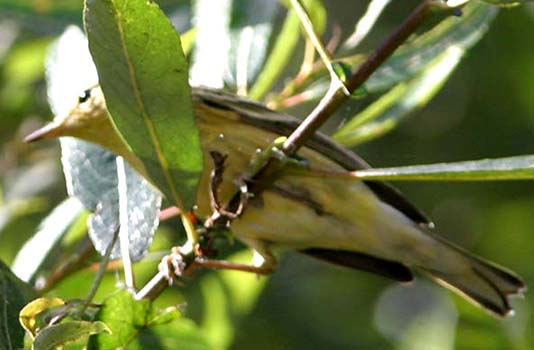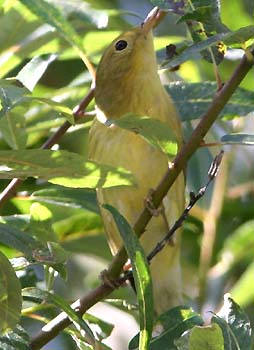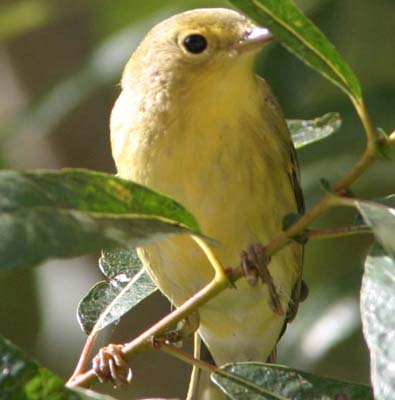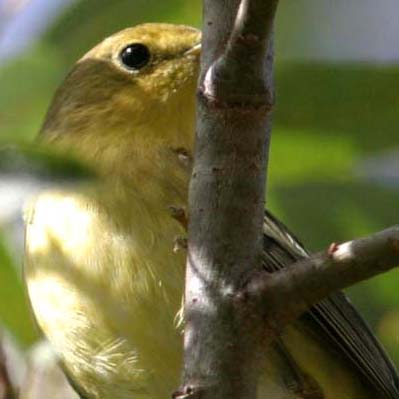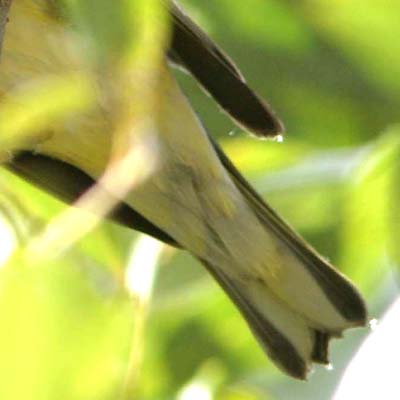|
|

| So here's good side view (above). The back and flanks are washed
yellow-olive and obscurely streaked. The tertials are blackish with broad
white edges; the primaries are thinly tipped with white. The upperpart
color is rather bright. The tail is short but the primary projection long.
This all suggests Bay-breasted. But the greater coverts seem odd: the 'wingbar'
(white tips to feathers) is rather obscure as outer edge of every feather
has a whitish to yellowish edge. More like Yellow?
Let's look at that face again (below). Sometimes the complete
and yellowish eyering is prominent (below left); at other times
lighting emphasizes a dusky loral area (below right). But the bird
lacks the well-defined transocular line associated with Blackpoll and Bay-breasted
Warblers. The rather lemony-yellow throat and breast is fine for Yellow
Warbler and also okay for Bay-breasted. Note (below left) the flesh-colored
feet in the light, but brownish-looking legs in the shadow. |
|
|
|
| From below (above left) the bird is mostly yellow (like Yellow
Warbler) but looks short-tailed and long-winged. What of the tail spots
(above right)? They were decidedly white (below) and cover
much of the inner web of the outer rectrix (above right). All the
rectrices are a bit worn and pointed, typical of HY birds. The amount of
white does not really seem consistent with drawings of Blackpoll or Bay-breasted
tail spots in Pyle (1997) but could be consistent with a Yellow Warbler
tail pattern if the color were yellow instead of white. |
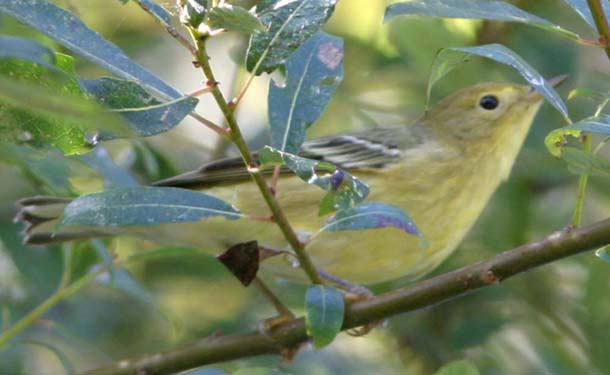
|
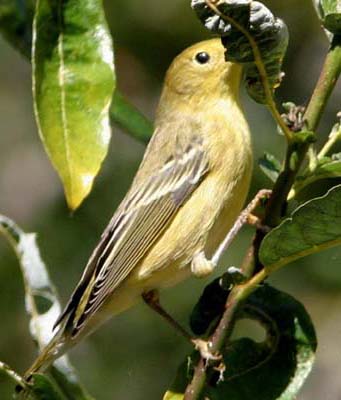
|
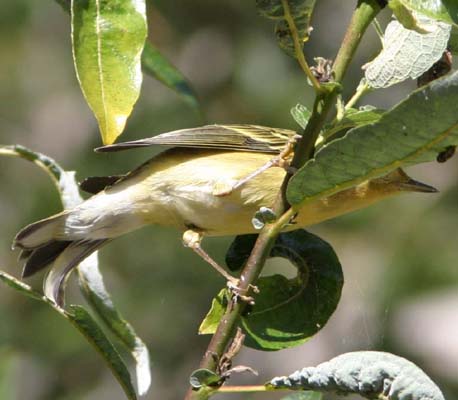
|
So we are left with a Yellow Warbler with apparent wingbars (above
left) and contrasting white undtertail coverts and white tail spots
(above right). Let's review the possibilities:
-
Yellow Warbler: face pattern and overall color are just fine; size and
bill and even the brief 'chip' heard were consistent. It was the size and
basic shape of a typical Yellow nearby. Yellow edgings to secondaries is
typical. But how to explain white wingbars, white undertail coverts, and
white tail spots?
-
Blackpoll Warbler: the obscure streaking to breast and back is good, as
are the brownish legs with flesh-cololed feet. But surely they can't have
a facial pattern without a transocular line and a cheek patch?
-
Pine Warbler: although some who saw the bird and looked at Sibley (2000)
suggested this species was the closest match, it seems entirely ruled out
on facial pattern, leg color, habitat, shape (e.g., long primary extension),
and the white tips to primaries (per Dunn & Garrett 1997)
-
Bay-breasted Warbler: although said to have the plainest facial pattern
of the 'Baypoll' group, surely it would have some eyestripe? Also the leg
color seems atypical (although perhaps within range; Dunn & Garrett
1997) but the nape did not seem green enough, the vent buffy enough, nor
the back streaks crisp enough. Whitney (1983) says 10-30% of fall Bay-breasteds
lack bay to the flanks; these are first-fall females. I think the specific
shape of the tail spots do not fit well, though. This was my first tentative
i.d. but it does not now seem right.
-
Hybrid? One would think that a hybrid would include Yellow Warbler as one
parent. Per Dunn & Garret (1997), the one 'possible' claimed hybrid
with Yellow was a Black-throated Blue. Nothing with wingbars.
So is this just a Yellow Warbler with wingbars and white vent & tail
spots? |
|
Literature cited:
-
Dunn, J.L,, and K.L. Garrett. 1997. A Field Guide to the Warblers of North
America. Houghton Mifflin, Boston.
-
Pyle, P. 1997. Identification Guide to North American Birds. Part I. Slate
Creek Press, Bolinas, CA.
-
Sibley, D.A. 2000. The Sibley Guide to Birds. Alfred A. Knopf, New York.
-
Whitney, B. 1983. Bay-breasted, Blackpoll, and Pine Warblers in fall plumage.
Birding 15: 219-222.
|
